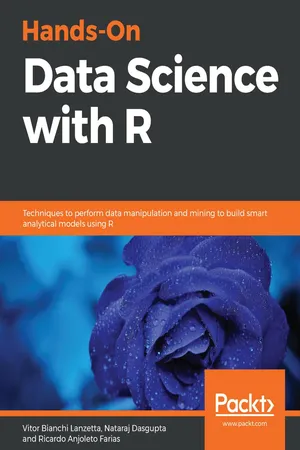
Hands-On Data Science with R
Techniques to perform data manipulation and mining to build smart analytical models using R
- 420 pages
- English
- ePUB (mobile friendly)
- Available on iOS & Android
Hands-On Data Science with R
Techniques to perform data manipulation and mining to build smart analytical models using R
About This Book
A hands-on guide for professionals to perform various data science tasks in R
Key Features
- Explore the popular R packages for data science
- Use R for efficient data mining, text analytics and feature engineering
- Become a thorough data science professional with the help of hands-on examples and use-cases in R
Book Description
R is the most widely used programming language, and when used in association with data science, this powerful combination will solve the complexities involved with unstructured datasets in the real world. This book covers the entire data science ecosystem for aspiring data scientists, right from zero to a level where you are confident enough to get hands-on with real-world data science problems.
The book starts with an introduction to data science and introduces readers to popular R libraries for executing data science routine tasks. This book covers all the important processes in data science such as data gathering, cleaning data, and then uncovering patterns from it. You will explore algorithms such as machine learning algorithms, predictive analytical models, and finally deep learning algorithms. You will learn to run the most powerful visualization packages available in R so as to ensure that you can easily derive insights from your data.
Towards the end, you will also learn how to integrate R with Spark and Hadoop and perform large-scale data analytics without much complexity.
What you will learn
- Understand the R programming language and its ecosystem of packages for data science
- Obtain and clean your data before processing
- Master essential exploratory techniques for summarizing data
- Examine various machine learning prediction, models
- Explore the H2O analytics platform in R for deep learning
- Apply data mining techniques to available datasets
- Work with interactive visualization packages in R
- Integrate R with Spark and Hadoop for large-scale data analytics
Who this book is for
If you are a budding data scientist keen to learn about the popular pandas library, or a Python developer looking to step into the world of data analysis, this book is the ideal resource you need to get started. Some programming experience in Python will be helpful to get the most out of this course
Frequently asked questions
Information
Machine Learning with R
– Alan Turing
- Which big companies are using machine learning
- Linear regression with base R
- Building decision trees with tree and rpart
- Random forest, bagging, and boosting methods
- Training support vector machines (SVM) with caret
- Building feedforward neural networks using h2o
What is machine learning?
Machine learning everywhere
Machine learning vocabulary
| Statistical jargon | Machine learning correspondent |
| Model estimation | Model training or learning |
| Estimation criteria | Cost function |
| Variables | Features |
| Independent variables | Inputs |
| Predicted values | Outputs |
| Dependent variables | Training or target values |
Generic problems solved by machine learning
Table of contents
- Title Page
- Copyright and Credits
- About Packt
- Contributors
- Preface
- Getting Started with Data Science and R
- Descriptive and Inferential Statistics
- Data Wrangling with R
- KDD, Data Mining, and Text Mining
- Data Analysis with R
- Machine Learning with R
- Forecasting and ML App with R
- Neural Networks and Deep Learning
- Markovian in R
- Visualizing Data
- Going to Production with R
- Large Scale Data Analytics with Hadoop
- R on Cloud
- The Road Ahead
- Other Books You May Enjoy